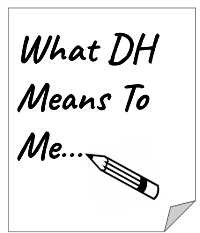The following piece was originally created for the DH@MSU Newsletter and was featured in the January 23, 2023 issue. Subscribe to the Newsletter here.
What DH Means To Me: Steve Rachman

Whether as a faculty member in the English department, a co-founder of the DHLC, a director of American Studies, or leading DH in the College of Arts & Letters, I have been working with Digital Humanities for more than twenty-five years and it meanings have shifted over that time, but I think the constants have lay in its usefulness for thinking about literature, reaching out to new communities, and creating new forms of access and scholarship.
My first encounter with this “thing” called or would come to be called Digital Humanities was probably in graduate school when I TA’d for Stuart Moulthrop who was then working on something he called a “hypertext novel,” at the time a new form of electronic literature that could be organized around hyperlinks rather than pages and indices. He showed me a prototype of how such a thing might work and when I came to MSU and taught a course on Rock music and culture, I made sure that I included one hypertext novel in the course, Sunshine ‘69 (https://bobbyrabyd.github.io/Sunshine69/noflash.html) by Bobby Rabyd which dealt with the Rolling Stones Altamont concert. We compared the novel to the Maysles’ documentary Gimme Shelter, and it was eye-opening to see how the digital presentation could frame and re-frame our history and understanding.
In the late 1990s, I collaborated with the MSU library on digitizing the Sunday School Book Collection for the American Memory Project of the Library of Congress and that resulted in the creation of the Shaping the Values of Youth project (https://d.lib.msu.edu/ssb) which is still part of MSU’s digital collections. The ability to give the world access to materials that were once impossibly obscure to many was tremendously exciting and we thought long and hard about designing the essays and the intellectual and textual apparatus to accompany the collection and make it useful to others. In the early aughts I engaged in a similar type of project with Matrix dealing with the Lam Qua’s paintings of the patients of Peter Parker, M.D. an American Medical Missionary in China. That project, too, raised a host of challenges in framing digitized materials for a global general audience and I was pleased and surprised at how they were handled (https://matrix.msu.edu/mystery-of-lam-qua#:~:text=The%20Mystery%20of%20Lam%20Qua,a%20wide%20range%20of%20patients.)
It has been gratifying to see how much scholarship has been generated around the globe by the use of these resources, often by scholars that would have no other means of access were it not for DH.
As I have moved on, I am always pleased and surprised by the collaborations that DH entails. They have taught me so much and forced me to test and reframe subjects, both those that I am very familiar with and those that are new to me. I always try to incorporate some DH technique in my work, often setting up a corpus of text data and looking for keywords before using more sophisticated modes. Just last week, I gave a new talk on neurology and nineteenth century American literature and much of its scope was facilitated by taking an approach to the literature rooted in digital techniques pioneered by practitioners of digital humanities. What was once new has become a robust tool for me and a crucial component of what it means to study literature and to share with our community and the world.